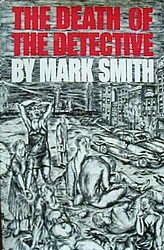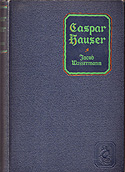from Chapter Twenty-Two: The Death of Scarponi
In Chicago there was half an hour of heavy rain. Underpasses flooded, water roared black and white along the gutters, and the streets and buildings gleamed as though shellacked. Throughout the city the name of Scarponi spelled itself repetitiously on the neon signs that hung before Scarponi’s liquor stores, reflecting in fuzzy, elongated, and glaring grean, red, and white letters on the slick black pavement of the streets.  Cars splashed through the colors, took and bent the letters momentarily on their trunks and hoods. Pedestrians who crossed the street stepped into an O, waded through a P, took the colors on their rubbers and domes of their umbrellas. Like spilled gasoline, streaks of color ran in the flooded streets. Inside the Scarponi stores, which were the size of supermarkets and like great technicolor billboards set out against the night, drowsy clerks stood in the aisles between the shelves of bottles and lines of empty grocery carts with their arms folded across their chests, or they leaned upon the counters by the cash registers, pencils tucked behind their ears, staring out through the downpour that rolled down the plate-glass window at the bedraggled, floundering, pedestrians and the creep and glitter of the traffic in the streets.
Cars splashed through the colors, took and bent the letters momentarily on their trunks and hoods. Pedestrians who crossed the street stepped into an O, waded through a P, took the colors on their rubbers and domes of their umbrellas. Like spilled gasoline, streaks of color ran in the flooded streets. Inside the Scarponi stores, which were the size of supermarkets and like great technicolor billboards set out against the night, drowsy clerks stood in the aisles between the shelves of bottles and lines of empty grocery carts with their arms folded across their chests, or they leaned upon the counters by the cash registers, pencils tucked behind their ears, staring out through the downpour that rolled down the plate-glass window at the bedraggled, floundering, pedestrians and the creep and glitter of the traffic in the streets.
It was tonight that the Tanker, who was not a professional killer but only a young car thief and burglar of far less experience than he liked to claimed, was to kill Scarponi. In fact he had been hired to kill him not once but twice and, although he did not know it, by two different men. On the shortest possible notice he had been ordered to follow the skeleton of a plan and to improvise the rest. He had received these orders from Romanski, who had allegedly received his from Fiore but actually from the Doctor, who had received his from his nephew Allegro, and he now in turn entrusted the first step of the plot to kill Scarponi to Ralph Borman, a boyhood friend. They had grown up together in the old North Side neighborhood of narrow, odd-sized frame houses often shingled in asphalt and in various stages of decay and expedient repairs, with no two of them on the same street the same color, looking as though they had been saved from demolition and moved to their present lots from somewhere else. It was a neighborhood that smelled of machine oil and the tannery on the river, that was traversed day and night by big trucks, where someone was always working on the engine of his car in the street and boys were interested in cars and jobs and money and left school at sixteen to apprentice to a trade. Both Tanker and Borman still lived in this neighborhood. Tanker knew that Borman needed the fifty dollars he had promised him if he would steal a late model Oldsmobile and leave it with the keys on the front seat at the designated hour in the parking lot of a restaurant in Edgebrook in the northwest section of the city. Friendship alone determined his selection of an accomplice. If Tanker had a favor to give, he gave it naturally to a friend. That Borman, in his opinion, was weak, unlucky, and incompetent only gave him, the stronger and more competent if not exactly always the luckier of the two, all the more reason for helping him. He felt responsible for his old friend.
At present Borman was under indictment for armed robbery but was out on the bail Tanker had arranged through Romanski. He had held up a cab driver, who, as his luck would have it, was a moonlighting cop. Upon hearing the childlike and apologetic voice at his back demanding his money and observing that the pistol pointed at him was made of plastic with a seam running down the center of the plugged-up barrel and the color of the plastic a kind of mauve, the policeman had taken his time in removing a thick piece of hose from the glove compartment (“I always carry an extra piece of hose with me,” he was later to tell the press, “because you never know when the hose to your radiator might spring a leak”), had taken his time in locking both rear doors, and taken his time in clubbing Borman unconscious on his seat. Tanker had first heard of it on the news in his car radio and had shouted out loud in surprise at the mention of his old friend’s name. It was typical of Borman’s destiny that the announcer treated robbery and robber with amusement, as did the newspapers in the morning. It was the light side of the news. Tanker had been puzzled by Borman’s resort to robbery. He thought he held a steady job as a bartender in an old-fashioned tavern in the old neighborhood. Located on a residential street corner that even the local residents rarely passed, it had large unwashed windows, steps you had to walk up to enter, and a musky air that smelled like beer thrown on the embers of a wood fire. Borman had stood behind the bar in a white apron and soiled white shirt, with his pale, fat, frightened face and his blond hair slicked down along his sideburns, looking as though he were afraid of being robbed, fired, or ordered to make a drink he had not heard of before. Even his numerous tattoos did not suggest military service, manliness, or evil so much as his having been held down forcibly by sadistic friends and mutilated.

 It was on April 1, in the midst of fetes, that the Universal Exhibition of 1867 was opened with triumphal splendor. The Empire’s great “season” was beginning, that supreme gala season which was to turn Paris into the hostelry of the entire world–a hostelry gay with bunting, song, and music, where there was feasting and love-making in every room. Never had a regime at the zenith of its power convoked the nations to such a colossal spree. From the four corners of the earth a long procession of emperors, kings, and princes started on the march towards the Tuileries, which were all ablaze like some palace in the crowning scene of an extravaganza.
It was on April 1, in the midst of fetes, that the Universal Exhibition of 1867 was opened with triumphal splendor. The Empire’s great “season” was beginning, that supreme gala season which was to turn Paris into the hostelry of the entire world–a hostelry gay with bunting, song, and music, where there was feasting and love-making in every room. Never had a regime at the zenith of its power convoked the nations to such a colossal spree. From the four corners of the earth a long procession of emperors, kings, and princes started on the march towards the Tuileries, which were all ablaze like some palace in the crowning scene of an extravaganza. So far as Caspar could remember he had always been in the same dark space, never anywhere else, always in the same space. Never had he seen a man, never had he heard his step, never had he heard his voice, never the song of a bird, never the cry of an animal; he had never seen the rays of the sun, nor the gleam of moonlight. He had never been aware of anything except himself, never becoming conscious of loneliness.
So far as Caspar could remember he had always been in the same dark space, never anywhere else, always in the same space. Never had he seen a man, never had he heard his step, never had he heard his voice, never the song of a bird, never the cry of an animal; he had never seen the rays of the sun, nor the gleam of moonlight. He had never been aware of anything except himself, never becoming conscious of loneliness.

